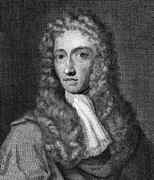Person: Boyle, Robert

Robert Boyle was an Irish-born scientist who was a founding fellow of the Royal Society. His work in chemistry was aimed at establishing it as a mathematical science based on a mechanistic theory of matter.
Mathematical Profile (Excerpt):
- Richard Boyle was in his 60s and Catherine Boyle in her 40s when Robert was born.
- At this stage of his time at Eton, Boyle's education was clearly going well.
- However, perhaps he had been given too much special attention by Harrison for, when Harrison retired, Boyle seemed unable to fit in with the educational discipline the new headmaster brought to the school.
- In Geneva Boyle studied with a private tutor French, Latin, rhetoric and religion.
- In 1641 Boyle learnt Italian in preparation for visiting there.
- In September of that year Boyle and his tutor were in Venice, then by the beginning of 1642 they were in Florence.
- Galileo died in his villa in Arcetri, near Florence, while Boyle was living in the city.
- If any one event shaped Boyle's life and directed him towards science, then it was this.
- Boyle became a strong supporter of Galileo's philosophy and believed strongly from this time in the new approach to studying the world through mathematics and mechanics.
- He did send £250 to pay for Boyle's return, but the money never reached him.
- Although Boyle inspected his new home after four months, it was much longer before he was able to move in.
- Although Boyle did not intend to spend long at Stalbridge, he remained there for around six years.
- This "new philosophical college" is also called by Boyle the "Invisible College" later in the letter.
- It is the society which would soon became the "Royal Society of London" and it provided Boyle's only contact with the world of science while he lived a somewhat lonely life at Stalbridge.
- It was discussions in the Invisible College which led to Boyle reading Oughtred's Clavis Mathematica as well as the works of Mersenne and Gassendi.
- Boyle had from the time of his visit to Italy favoured the ideas of Copernicus and he now held these views deeply, together with a deep belief in the atomic theory of matter.
- This period was a difficult one for Boyle for he tried hard not to be forced to take sides in the civil war.
- Boyle went to Ireland in 1652 to look after his estates there.
- It should be noted, however, that Boyle was a very generous man with his money, and many around him benefited from this generosity.
- Boyle met John Wilkins, the leader of the Invisible College, in London when he visited there in 1653.
- He strongly encouraged Boyle to join them in Oxford and invited him to live in the College.
- Boyle decided to go to Oxford but preferred not to accept Wilkins' offer of accommodation, choosing instead to arrange his own rooms where he could carry out his scientific experiments.
- From 1654 Boyle lived in Oxford, although he never held any university post.
- He made important contributions to physics and chemistry and is best known for Boyle's law (sometimes called Mariotte's Law) describing an ideal gas.
- Boyle's law appears in an appendix written in 1662 to his work New Experiments Physio-Mechanicall, Touching the Spring of the Air and its Effects (1660).
- The apparatus had been designed by Hooke and using it Boyle had discovered a whole series of important facts.
- The 1662 appendix did not only contain Boyle's law which relates volume and pressure in a gas, but it also contained a defence of Boyle's work on the vacuum which appeared in the main text.
- Many scientists, particularly Hobbes, had argued that a vacuum could not exist and claimed that Boyle's results obtained with the vacuum pump must be the result of some as yet undiscovered force.
- Another book by Boyle in 1666 was called Hydrostatic paradoxes.
- In The Sceptical Chemist (1661) Boyle argued against Aristotle's view of the four elements of earth, air, fire and water.
- Boyle's ideas that the primary particles move freely in fluids, less freely in solids, followed Descartes.
- Boyle had conducted many experiments which led him to believe in a vacuum and, having found no experimental evidence of the ether, to reject that idea.
- In considering optics, in particular colour, Boyle was not so successful.
- Boyle was a founding fellow of the Royal Society.
- It is for this reason that we have decided to include Boyle into this archive of mathematicians for, although he did not develop any mathematical ideas himself, he was one of the first to argue that all science should be developed as an application of mathematics.
- Although others before him had applied mathematics to physics, Boyle was one of the first to extend the application of mathematics to chemistry which he tried to develop as a science whose complex appearance was merely the result on simple mathematical laws applied to simple fundamental particles.
- Some however, were keen to find Boyle a wife.
- Boyle seemed to have successfully avoided such attempts to marry him off.
- The religious side of Boyle is one which we have not mentioned in this biography, yet it was an important force in his life.
Born 25 January 1627, Lismore, County Waterford, Ireland. Died 30 December 1691, London, England.
View full biography at MacTutor
Tags relevant for this person:
Analysis, Astronomy, Geometry, Origin Ireland, Physics
Thank you to the contributors under CC BY-SA 4.0! 

- Github:
-

- non-Github:
- @J-J-O'Connor
- @E-F-Robertson
References
Adapted from other CC BY-SA 4.0 Sources:
- O’Connor, John J; Robertson, Edmund F: MacTutor History of Mathematics Archive
